Shadows online programme
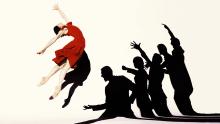
Performance information
Voorstellingsinformatie
Performance information
Regnum
Choreography
Milena Sidorova
Music
Wolfgang Amadeus Mozart – Symphony No. 25 in G minor (1773)
Set design
Anna Dohy
Costume design
François-Noël Cherpin
Lighting design
Wijnand van der Horst
Ballet master
Jozef Varga
Yugen
Choreography
Wayne McGregor
Music
Leonard Bernstein – Chichester Psalms (1965)
Set design
Edmund de Waal
Costume design
Shirin Guild
Lighting design
Lucy Carter
Staging
Amanda Eyles, using the Benesh notation score of the balle
Associate lighting designer
John-Paul Percox
Ballet master
Sandrine Leroy
Production manager Royal Opera House
Colin Maxwell
Choir
Cappella Amsterdam directed by Daniel Reuss
Soloists
Martha Bosch (soprano)
Ludmila Schwartzwalder (alto)
Jon Etxabe Arzuaga (tenor)
Johan Vermeer (bass)
Soloist Nationale Koren
Rik de Jong (boy soloist)
Yugen is a co-production between Dutch National Ballet and The Royal Ballet
The Green Table
Choreography and libretto
Kurt Jooss
Music
F. A. Cohen – The Green Table (1932)
Piano
Olga Khoziainova
Mikhail Murach
Set and costume design
Hein Heckroth
Lighting design and masks
Hermann Markard
Lighting supervisor
Berry Claassen
Staging and supervision
Jeanette Vondersaar
Co-stager and repetiteur
Claudio Schellino
Assistant repetiteur
Freek Damen
Ballet master
Judy Maelor Thomas
Original staging (together with Kurt Jooss, taking over after his death)
Anna Markard
Original production created by
Deutsche Oper am Rhein Düsseldorf Duisburg
You are kindly requested to applaud only at the end of The Green Table and not in between the separate parts.
Thank you for your cooperation.
Musical accompaniment
Dutch Ballet Orchestra conducted by Matthew Rowe
Sets, props, wigs and makeup, lighting and sound
Technical department of Dutch National Opera & Ballet
Production manager
Anu Viheriäranta
Stage managers
Wolfgang Tietze
Kees Prince
Production supervisor
Puck Rudolph
First carpenter
Peter Brem
Lighting managers
Michel van Reijn
Angela Leuthold
Lighting supervisor
Wijnand van der Horst
Sound technician
Florian Jankowski
Follow spotters
Panos Mitsopoulos
Carola Robert
Marleen van Veen
Titus Franssen
Coordinator follow spotters
Ariane Kamminga
Costume production
Costume department Dutch National Ballet in collaboration with Martine Douma
Assistant costume production
Michelle Cantwell
First dresser
Andrei Brey
First makeup artist
Isabel Ahn
Special effects and props
Ruud Sloos
Koen Flierman
Introduction
Jacq. Algra
Mirjam Midderham
Cast sheet
castlijst
Cast sheet
Wednesday 28 September
REGNUM
Part II
Chloë Réveillon
Jakob Feyferlik
Victor Caixeta
Part I - III - IV
Alexandria Marx, Mila Nicolussi Caviglia, Emma Mardegan, Arianna Maldini, Laura Rosillo, Khayla Fitzpatrick, Hannah de Klein, Sandra Quintyn, Claire-Tjoe Fat, Sebia Plantefève-Castryck
Jakob Feyferlik, Dustin True, Sho Yamada, Rémy Catalan, Bela Erlandson, Sander Baaij, Giovanni Princic, Leo Hepler, Guillermo Torrijos, Pascal Johnson
YUGEN
Lamb
Anna Ol
Hayward
Riho Sakamoto
Takada
Jessica Xuan
Hamilton
Floor Eimers
Katsura
Connie Vowles
Bonelli
Artur Shesterikov
Richardson
Timothy van Poucke
Sissens
Edo Wijnen
Kay
James Stout
Bracewell
Joseph Massarelli
Serrano
Dingkai Bai
THE GREEN TABLE
Death
Giorgi Potskhishvili
Standard Bearer
Martin ten Kortenaar
Young soldier
Jan Spunda
Young girl
Qian Liu
Woman
Anna Tsygankova
Old soldier
Artur Shesterikov
Old mother
Kira Hilli
Profiteer
Edo Wijnen
Soldiers
Giovanni Princic, Dingkai Bai, Rafael Valdez
Women
Sebia Plantefève-Castryck, Alexandria Marx, Arianna Maldini, Wendeline Wijkstra, Connie Vowles
Synopsis
Click on the link below to read the synopses of Regnum, Yugen and The Green Table.
Synopsis
Regnum
Powerful ballet set to timeless Mozart composition
Shadows opens with a world premiere by Young Creative Associate Milena Sidorova. After creating Reset in September 2020 for the programme Dancing Apart Together, Regnum – Latin for reign – is her second work for Dutch National Ballet’s regular programme. Inspired by Mozart’s timeless Symphony No. 25, she has created a forceful ballet for 22 dancers, about power and the means people use to gain it, both in personal relationships and in society as a whole. Do these means lead to power, or is it the other way around? Which means are most important? How do you use them, and at what cost?
Whereas the concept for Regnum was inspired by Mozart’s music, the resulting choreography is based mainly on the individual qualities of the 22 dancers performing the work. Sidorova therefore created most of the movements during the studio rehearsals with the dancers, and experimentation formed an important part of the creative process.
As in the case of her previous ballets, Sidorova wanted Regnum to be an original work that intrigues ballet enthusiasts, but can be understood and appreciated by everyone. In order to realise such a unique audience experience, she entered into collaboration with game designer Anna Dohy, who is making her debut as a set designer. The costumes for the ballet are designed by François-Noël Cherpin.
Yugen
In co-production with The Royal Ballet, Dutch National Ballet presents the European premiere of Wayne McGregor’s Yugen (Japanese for sublime beauty).
For this ballet, which met with great acclaim in London at the beginning of 2018, McGregor was inspired by Leonard Bernstein’s Chichester Psalms, an eclectic mix of Hebrew texts, Christian choral music and Broadway jazz. McGregor gives an impressive and exceptionally musical interpretation of this monumental composition, alternating beautiful, lyrical dance scenes with powerful, dynamic group sections. “One of the most rich and accomplished classical works of McGregor’s career”, wrote the Guardian. The Times stated, “The choreography, multifaceted, effervescent and elusive, is suffused with passion – romantic and religious, secular and biblical – and delivered with an unfussy embrace of the classical language.”
For Yugen, McGregor collaborated with the British ceramic artist Edmund de Waal, who designed the sets, and the renowned British-Iranian fashion designer Shirin Guild, who designed the costumes.
Yugen is the second work by McGregor to be taken into Dutch National Ballet’s repertoire, following the company’s extremely successful performances of his masterpiece Chroma, in 2015 and 2018.
The Green Table
A poignant anti-war ballet
As one of the masterpieces of German Ausdruckstanz, The Green Table is part of the canon of international dance history. The work is one of the first examples of social criticism in dance, although that was not Jooss’ original intention. The ballet, which came as a bombshell at its premiere in Paris, in 1932, is an indictment against warfare and a demonstration of its futility.
For The Green Table, Jooss took inspiration from the medieval dance of death, which was often performed after plague epidemics. The dance illustrates the power of death over the living. In the 1920’s, Jooss saw the famous ‘Lübecker Totentanz’. It fascinated him and he used the experience as a source of inspiration for The Green Table. He worked on developing his idea for about ten years, describing the creation process as follows: “This work arose from various sources, which eventually grew towards one another in a way I had no hold over, to form a new whole.” Even though it was not his express intention, The Green Table is clearly a product of its times. World War I, in which millions of soldiers died, had ended just fourteen years earlier, and the tensions concerning the rise of National Socialism in Germany were palpable.
The Green Table begins and ends with a grotesque mime scene that appears to be a satirical representation of negotiations between politicians and diplomats around a conference table. Jooss himself always said he didn’t know exactly who these men were. “There may be a couple of diplomats among them, but I think I mainly wanted to symbolise the powers who bring about war through their machinations.”
In between, the dance scenes subtly and often movingly sketch the fate of a young and an old soldier, a standard-bearer, a partisan, a young girl, an elderly mother and a profiteer. One by one, they are robbed of their life by Death, symbolised by a character that is somewhere between a soldier and a skeleton. A dramatic highlight is the poignant, quiet round dance, in which Death (impressively portrayed by Jooss himself in 1932) triumphantly leads the procession of victims, as in a medieval dance of death.
Besides the fact that The Green Table gained fame for its theme, the choreography also played a role in acquiring the status of ‘classic’ in the modern dance world. The combination of expressionist Ausdruckstanz and quiet mime lends a unique character to the dancing. Based on his concept of ‘essentialism’, Jooss left out all unnecessary movements, whilst each movement must express an idea and be inspired by an emotion.
Over the years, The Green Table has remained practically unchanged. Anna Markard, Jooss’ daughter, has ensured that not a single element has been altered since the death of her father.
Author: Astrid van Leeuwen
Interview with Milena Sidorova
During her 17-year dance career with Dutch National Ballet, the Ukrainian-Dutch Milena Sidorova already created more than 20 choreographies. We spoke to her about her latest work Regnum. Sidorova: ‘Regnum has become a darker piece than I originally had in mind’.
‘Regnum has become a darker piece than I originally had in mind’
During her 17-year dance career with Dutch National Ballet, the Ukrainian-Dutch Milena Sidorova already created more than 20 choreographies, part of which in the position of Young Creative Associate with the company. Having recently decided to continue as a full-time choreographer, she now embraces the task of opening the 2022/2023 season with her latest ballet Regnum, set to Mozart’s Symphony No. 25.
What story do you want to tell with Regnum?
“Regnum is about power; about powerful and powerless people, and everyone in between. And particularly about the pursuit of means that can help you gain power. The ballet has different storylines related to these themes. In various combinations – solos, duets, trios and groups – the 22 dancers embody the characters and relationships within these stories. Some storylines are more obvious than others, and they don’t all have to be followed by the audience. For me, the main thing is that viewers get caught up in the work and enjoy it.”
Before becoming a full-time choreographer, you’d already been dancing with Dutch National Ballet for a long time. What’s it like now, standing at the front of the studio and working with your former fellow dancers?
“I’ve worked with most of the dancers from the company before in my role as a choreographer – after Reset (September 2020 – ed.), Regnum is my second work for the regular programme of the main company – and I’m really enjoying it. Everyone’s hugely talented and I think it’s actually an advantage to have already worked as a dancer with many of them. It means I know them well; exactly where their strengths lie and how to bring out the best in them. However, Regnum is my first work with a full orchestra and custom-made sets, and, with 22 dancers per cast, the group is bigger this time. With two full casts and a partial third cast, it means there are sometimes nearly fifty people in the studio at once. That was something I had to get used to at the beginning.
What role did Mozart’s Symphony No. 25 play in the creative process?
“For some time already, I’d wanted to make a work about power, and when I first heard Mozart’s Symphony No. 25 – an absolute masterpiece – I immediately felt how well it fit the theme. The work has such wonderful drama, intensity, melodic lines, emotional extremes and sudden changes in tempo and dynamics. It’s the perfect composition for choreographing a ballet and it formed an important source of inspiration for the concept of Regnum.”
The original season opener Celebrate! has been replaced by the present programme Shadows. How do you feel about that?
“I’m really happy with the change, and I think Shadows suits the current situation better. I was born in Kyiv and feel very strong sympathy for the people in Ukraine who are suffering the unjustified war with Russia. It’s hard to imagine that such a terrible war is raging at the moment in Europe. It has all had a big influence on me over the past months, and therefore on my choreographic work as well.”
In what way?
“My ballets are usually quite light and hopeful, but now the world has become a darker place it’s inevitable that this should be reflected in my work. So Regnum has become a darker piece than I originally had in mind. If you were to ask me what it would have looked like if there’d been no war in Ukraine, I wouldn’t be able to answer. Because the situation is as it is: the world has changed.”
Author: Rosalie Overing
Edmund de Waal on his set designs for Yugen
At the end of 2016, Edmund de Waal received a letter from Wayne McGregor. ‘I have a collaborative project I would like to share with you.’ De Waal: ‘Would I be interested in working on a piece based on the psalms?’
Poetry in Motion: Edmund de Waal on his set designs for Yugen
Almost 18 months ago (at the end of 2016 – ed.), I received a letter from Wayne McGregor. ‘I have a collaborative project I would like to share with you.’ Would I be interested in working on a piece based on the psalms?
I love Wayne’s work. He is one of those figures who seems to thrive on collaboration, joining forces with a kaleidoscopic series of musicians, architects, scientists, writers and visual artists. His Woolf Works at The Royal Opera House, using the writings of Virginia Woolf, had deeply affected me.
But the letter came out of the blue. I’d never worked with a choreographer, never designed for a stage. But I’d grown up with the psalms and was planning an installation based around them for the Ghetto in Venice. I said yes. I said yes and then read the contract. And then I wrote in my notebook that all good collaboration contains risk.
IDEAS IN MOTION
So this is how I found myself at the first rehearsal on a February Monday morning in the Ashton studio at the Royal Opera House, a top-lit space with grey floors, mirrors, a deep silence. There is a window into a corridor, and faces appear at intervals. Today there are three dancers, Sarah, Matt and Olivia – it should have been four but one is injured, a reminder of the profoundly taxing world that dancers live in. There’s also Amanda, who, miraculously, takes notes of the unfolding movements. And Wayne. I sit on the floor with a notebook, trying to disappear. I start by trying to write down what I see and hear, but that feels too intrusive. So I sit.
Wayne starts with one particular movement. And then he says, ‘Can you move here?’ He shows, describes, and intimates, a long, lithe black shape always in motion around the pair of dancers. It’s a series of touches, an exchange of energy, a pulse. And a conversation of request and enquiry, a checking of aspiration against the particularity of these two people and their own knowledge. I love this. I’d expected a more didactic process but this is exploratory and testing. ‘Keep the air,’ he says. ‘Keep the negative space between bodies.’ ‘Your hands should be touching the heads of children.’ ‘This part is like walking in sand.’ ‘Bless the floor here.’
And after an hour of repetition, there is a minute of dance.
What I’m seeing is ideas in motion, a shape-shifting, a breathing through the flow of images into a language for this new work, Chichester Psalms.
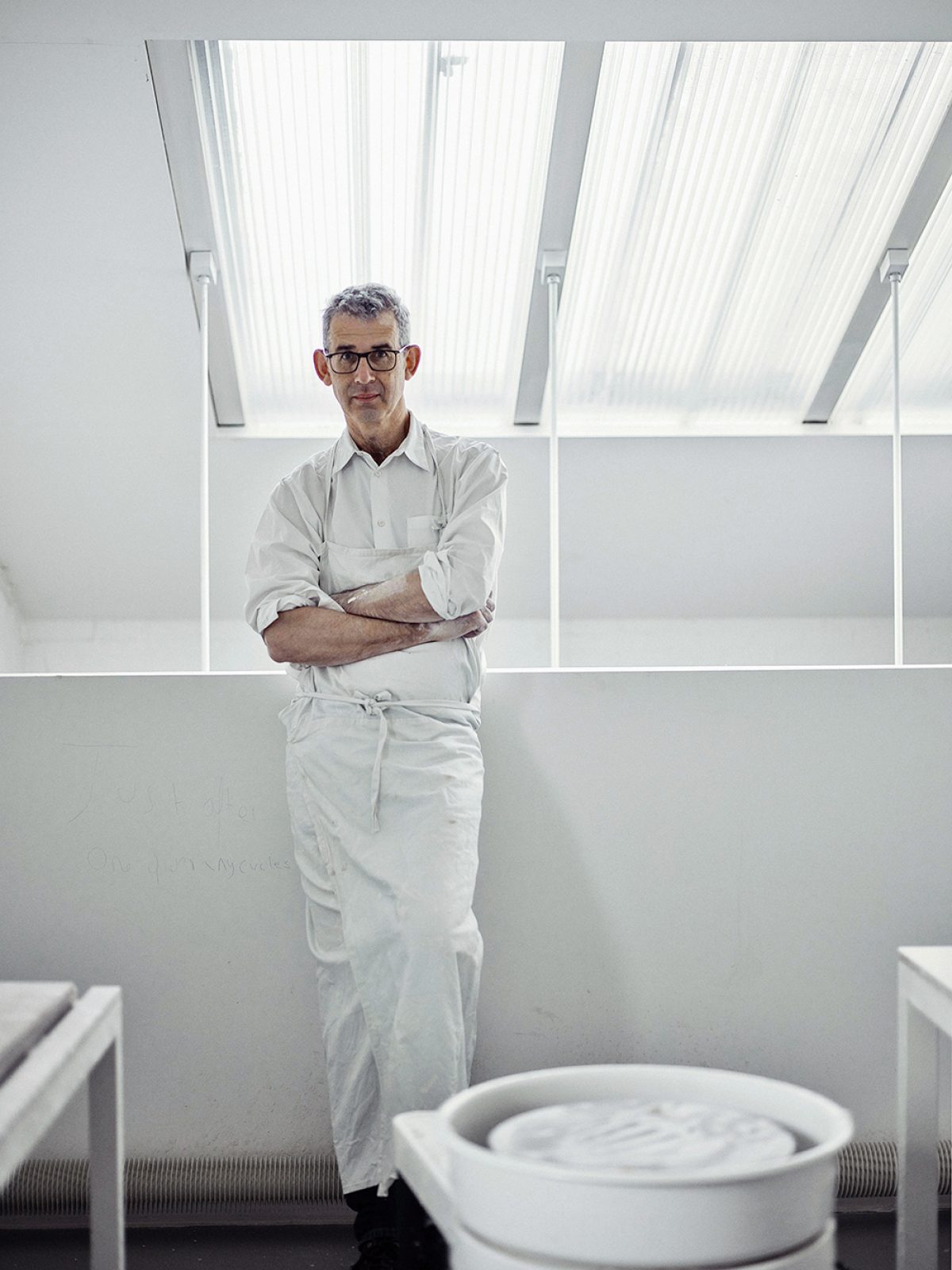
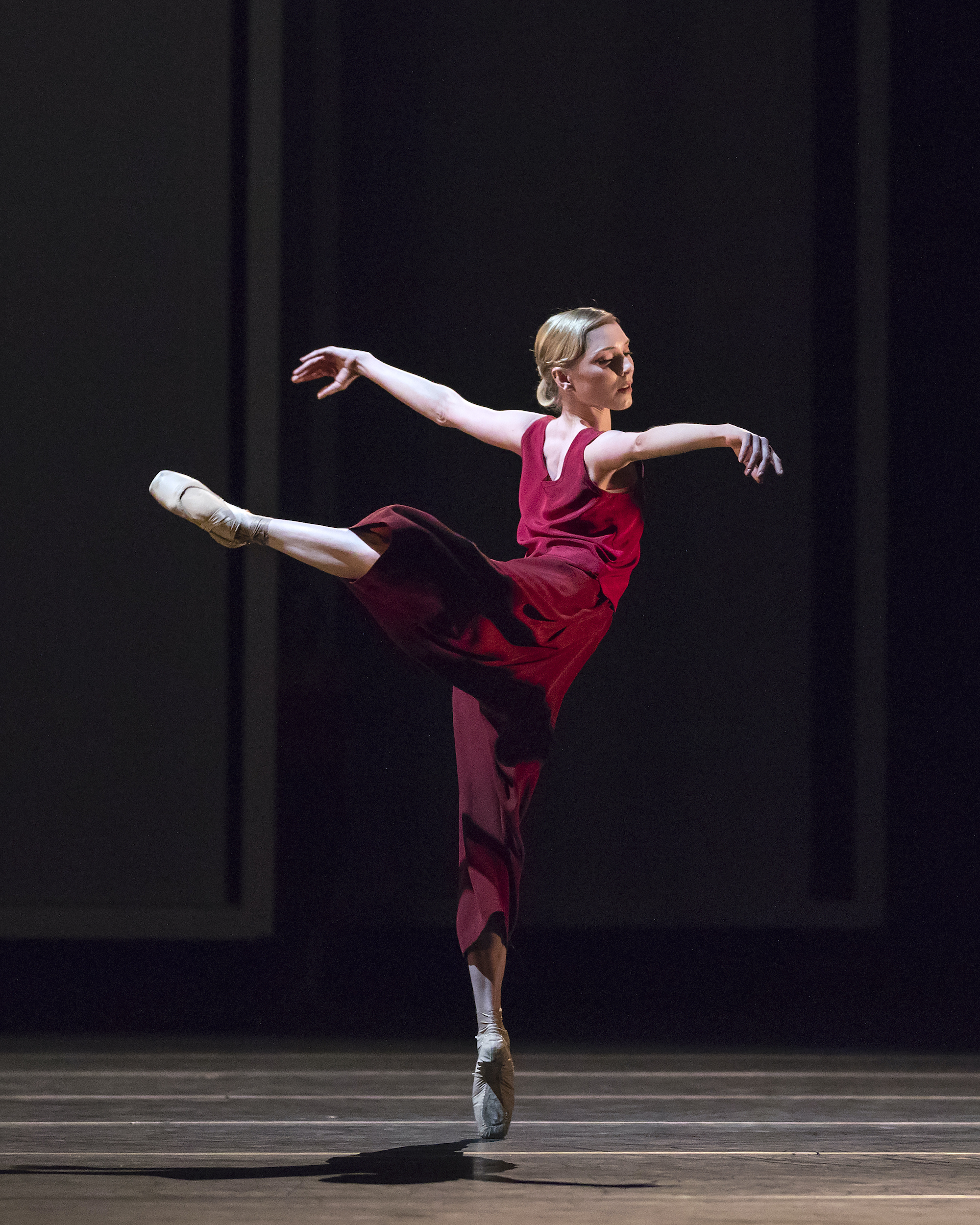
BERNSTEIN
My practice is grounded in the solitary making of pots, but the range of projects I do means that my studio hosts a cheerful ebb and flow of people. However, on Fridays I have the place to myself. It is an essential day when I work out what I’m doing. For the past year I’ve played the Chichester Psalms loudly. And worked on how to stage it, how to help create a place for movement and voice that works with these hauntingly beautiful texts.
The Chichester Psalms were commissioned from Leonard Bernstein in 1965 by the Very Rev. Walter Hussey, the Dean of Chichester Cathedral. He was a truly unusual Anglican clergyman, a passionate advocate for the place of the contemporary arts in the Church, arguing that there was an imperative to bring the most radical artists, poets and composers into connections with Christianity. In his parish in Northampton in the 1940s, he had persuaded Henry Moore to carve a Madonna and Child and Benjamin Britten to compose an anthem. At Chichester, he initiated remarkable commissions of painting from Graham Sutherland and stained glass from Marc Chagall. This was visionary stuff.
Bernstein was famous and Jewish, like Chagall. His Young People’s Concerts, where he articulated the inner meanings of music with chutzpah, had given him an extraordinary platform. West Side Story was a storied success. And he had conducted President Kennedy’s pre-inaugural gala and Mahler’s Resurrection Symphony the day after his assassination, later composing the Kaddish symphony in his memory, a threnody for extinguished hope. The personal and the national were intertwined. For Chichester, he set six psalms in three movements, to be sung in Hebrew. A boy treble sings solo alongside the choir in an echo of the psalms’ origin as the ‘Songs of David’. Bernstein was explicit he had written this part ‘with boys’ voices in mind’. The work begins with a powerful, declamatory introduction, which translates to: ‘Awake, psaltery and harp: I will rouse the dawn!’ Timpani and a harp explore with the first dramatic sounds. The psalms themselves span the troubled – ‘Why do the nations rage, and the people imagine a vain thing? The kings of the earth set themselves, and the rules take counsel together, against the Lord’ – to the affirmative: ‘I will dwell in the house of the Lord forever.’ These psalms keep moving between the singular and the plural, the solitary voice and the tribal. This was my key.
PLACES OF REFUGE AND PAUSE
This is personal. I grew up in cathedrals, first Lincoln, and then Canterbury, as part of a clergy family. I heard the psalms as part of the day-to-day rhythm of the services: they were embedded in matins in the mornings and evensong at the end of the afternoon, the echoes of the great monastic series of eight offices (prayer services) that spanned the day and the night before the Reformation. My brothers and I used to borrow a key at night and explore the cathedral, the floodlights burning strange itinerant shadows into the building. One memorable night 40 years ago, we heard the monks from Bec Abbey in Normandy sing the psalms in Canterbury Cathedral for the first time in 500 years.
How music works across spaces, how light moves, became part of my life. I’ve used porcelain vessels to create installations – grouping them in domestic spaces, the dome of a museum, galleries. The choreography of objects, how they work in rhythm and with dynamics of pause and release, is what I do. But when thinking of bodies in space I kept returning to the images of bodies paused in mid-flight – the photographs from the 1950s of the young radical choreographer Merce Cunningham at Black Mountain College in North Carolina, where he becomes a kind of graphic mark, like a Chinese brushstroke on a scroll. I wondered if it was possible to create structures for the dancer, places of refuge and pause. They needed to be beautiful, exactingly so. I wanted them to flare into light – to act as light boxes on a stage that has been stripped back to its vast blackness. They had to be visible to the complex sight lines. And moveable – this is a co-production with Dutch National Ballet – and storable and affordable. And ready for first night.
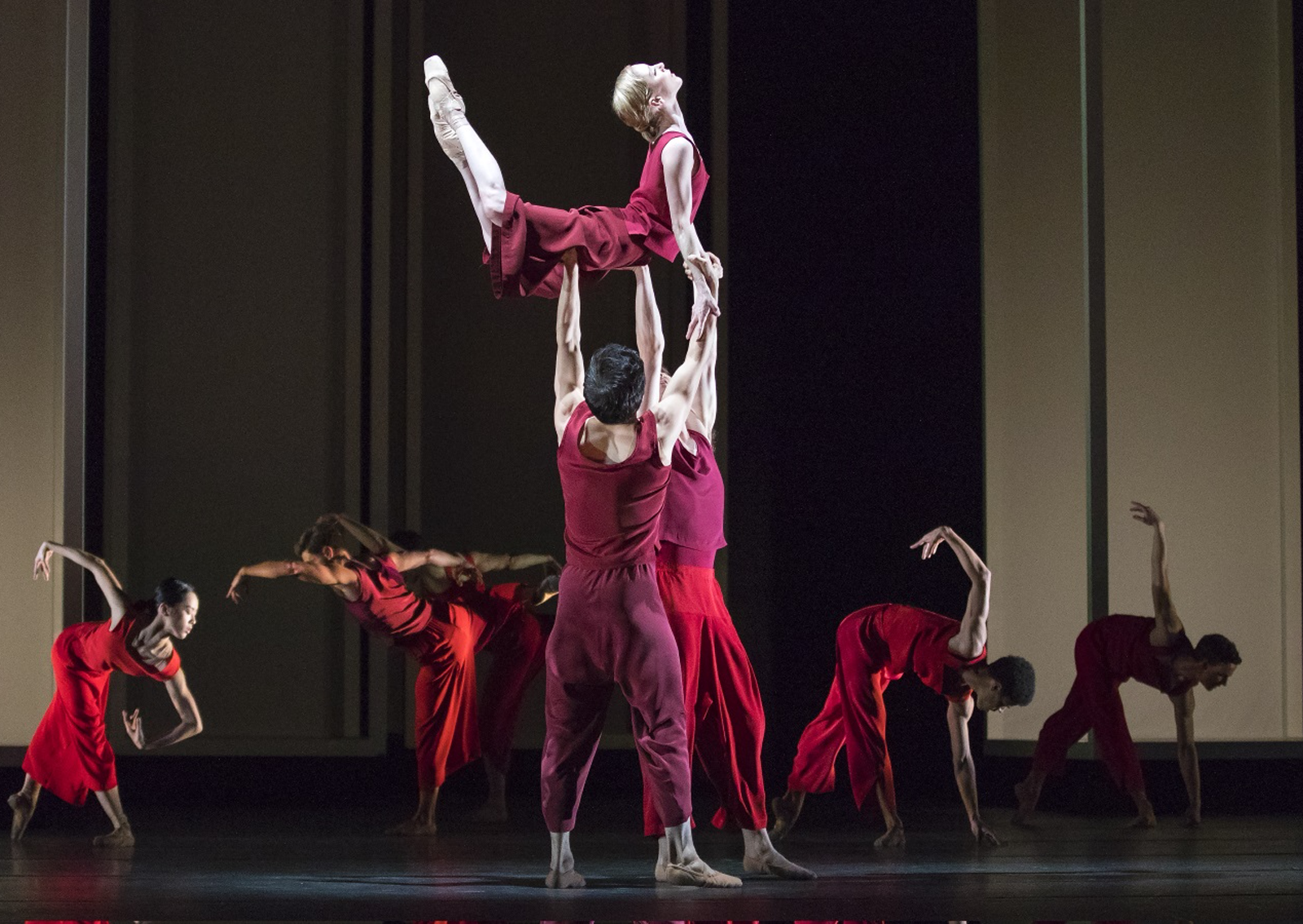
COLLABORATIONS
So, in the year before the premiere at The Royal Opera House, I spent time with Wayne both in his extraordinary new space in Stratford in the Queen Elizabeth Olympic Park – created by the architectural practice WeNotI – and getting to know the Royal Opera House in Covent Garden. It is less a building and more a story written by Jorge Luis Borges, a labyrinth of skills and knowledge. Get lost and you end up in the armoury; or the dye shop, where vats of colour are being stirred; or in a rehearsal for Carmen, as I did, to my embarrassment. One corridor ends in baroque gowns, another in dancers stretching, and a lift provides conversations with Keon Kessels, the music director of The Royal Ballet, about the score. Working with Colin Maxwell, the production manager and Lucy Carter, the lighting designer, to understand the spillage of light, or Catherine Smith in the model room to make exactingly precise sets in miniature and figure out the right proportions, has been a formidable exercise in learning how to make this work. Collaborating with the fashion designer Shirin Guild, a friend for over 20 years, to think through the colour of this production has been fascinating. For though the psalms are often heartbreaking – they are songs of exile – we kept returning to their essential assertion of life. The spectrum of pomegranate colours – reds, orange and maroons – created using vegetable dyes from villages in Iran brought this depth.
It is going to happen. These dancers, this choir, a single boy. The music and the space. Ideas in motion – at last.
Set designer Edmund de Waal (visual artist, master potter and author) wrote this essay for the programme of The Royal Opera House, where Yugen premiered in March of 2018.
©Edmund de Waal/Telegraph Media Group Limited 2018
Chichester Psalms
Wayne McGregor’s source of inspiration for Yugen was Leonard Bernstein's breathtaking Chichester Psalms, an eclectic mix of Hebrew text, Christian choral music and Broadway jazz. Follow the link below to read the original text and the English translation of the psalms.
Chichester Psalms
Chichester Psalms
Psalm 108:2 and psalm 100
| Psalm 108:2 | Psalm 108:2 |
| Urah, hanevel, v’chinor! | Awake, psaltery and harp! |
| A-irah shahar! | I will rouse the dawn! |
|
Psalm 100 |
Psalm 100 |
| Hariu l’Adonai kol haarets. | Make a joyful noise unto the Lord all ye lands. |
| lv’du et Adonai b’simha | Serve the Lord with gladness. |
| Bo-u l’fanav bir’nanah. | Come before his presence with singing |
| D’u ki Adonai Hu Elohim | Know ye that the Lord, He is God. |
| Hu asanu, v’lo anahnu. | It is He that hath made us, and not we ourselves. |
| Arno v’tson mar’ito. | We are His people and the sheep of His pasture. |
| Bo-u sh’arav b’todah, | Enter into His gates with thanksgiving, |
| Hatseirotav bit’hilah, | And into His courts with praise. |
| Hodu Io, bar’chu sh’mo. | Be thankful unto Him, and bless His name. |
| Ki tov Adonai, l’olam has’do, | For the Lord is good, His mercy is everlasting. |
| V’ad dor vador emunato. | And His truth endureth to all generations. |
LI. PSALM 23 AND PSALM 2:1-4
| Psalm 23:1-4 | Psalm 23:1-4 |
| Adonai ro-i, lo ehsar. | The Lord is my shepherd, I shall not want. |
| Bin'ot deshe yarbitseini, | He maketh me to lie down in green pastures, |
| Al mei m'nuhot y'nahaleini, | He leadeth me beside the still waters, |
| Naf'shi y'shovev, | He restoreth my soul, |
| Yan'heini b'ma'aglei tsedek, | He leadeth me in the paths of righteousness, |
| L'ma'an sh'mo. | For His name's sake. |
| Gam ki eilech | Yea, though I walk |
| B'gei tsalmavet, | Through the valley of the shadow of death, |
| Lo ira ra, | I will fear no evil, |
| Ki Atah imadi. | For Thou art with me. |
| Shiv't'cha umishan'techa | Thy rod and Thy staff |
| Hemah y'nahamuni. | They comfort me. |
| Lamah rag'shu goyim | Why do the nations rage, |
| Ul'umim yeh'gu rik? | And the people imagine a vain thing |
| Yit'yats'vu malchei erets, | The kings of the earth set themselves, |
| V'roznim nos'du yahad | And the rulers take counsel together |
| Al Adonai v'al m'shiho. | Against the Lord and against His annointed. |
| N'natkah et mos'roteimo, | Saying, let us break their bonds asunder, |
| Yoshev bashamayim | He that sitteth in the heavens |
| Yis'hak, Adonai | Shall laugh, and the Lord |
| Yil'ag lamo! | Shall have them in derision! |
|
Psalm 23:5-6 |
Psalm 23:5-6 |
| Ta'aroch l'fanai shulchan | Thou preparest a table before me |
| Neged tsor'rai | In the presence of mine enemies, |
| Dishanta vashemen roshi | Thou annointest my head with oil, |
| Cosi r'vayah. | My cup runneth over. |
| Ach tov vahesed | Surely goodness and mercy |
| Yird'funi kol y'mei hayai | Shall follow me all the days of my life, |
| V'shav'ti b'veit Adonai | And I will dwell in the house of the Lord |
| L'orech yamim. | Forever. |
LLI. PSALM 131 AND PSALM 133:1
| Psalm 131 | Psalm 131 |
| Adonai, Adonai, | Lord, Lord, |
| Lo gavah libi, | My heart is not haughty, |
| V'lo ramu einai, | Nor mine eyes lofty, |
| V'lo hilachti | Neither do I exercise myself |
| Big'dolot uv'niflaot | In great matters or in things |
| Mimeni. | Too wonderful for me to understand. |
| Im lo shiviti | Surely I have calmed |
| V'domam'ti, | And quieted myself, |
| Naf'shi k'gamul alei imo, | As a child that is weaned of his mother, |
| Kagamul alai naf'shi. | My soul is even as a weaned child. |
| Yahel Yis'rael el Adonai | Let Israel hope in the Lord |
| Me'atah v'ad olam. | From henceforth and forever. |
|
Psalm 133:1 |
Psalm 133:1 |
| Hineh mah tov, | Behold how good, |
| Umah nayim, | And how pleasant it is, |
| Shevet ahim | For brethren to dwell |
| Gam yahad. | Together in unity. |
Interview with Jeanette Vondersaar about The Green Table
She finds it incredibly sad, but Kurt Jooss’ The Green Table is unfortunately still relevant, especially at the moment. According to Jeanette Vondersaar, it is therefore extremely important that Dutch National Ballet performs Jooss’ ‘anti-war ballet’ right now, when a terrible war is raging in Europe.
The Green Table: keeping a masterpiece alive
She finds it incredibly sad, but Kurt Jooss’ The Green Table is unfortunately still relevant, especially at the moment. According to Jeanette Vondersaar, it is therefore extremely important that Dutch National Ballet performs Jooss’ ‘anti-war ballet’ right now, when a terrible war is raging in Europe.
As a former principal dancer with Dutch National Ballet, she often performed the role of the partisan in the ballet. Later on, she assisted Jooss’ daughter, Anna Markard, in staging the work, and since Markard’s death in 2010, Vondersaar has been responsible for keeping this masterpiece ‘alive’.
Jeanette Vondersaar, born in Indianapolis, America, was sixteen when she first saw The Green Table, as a ballet student in New York. “The ballet made a deep impression on me, particularly the role of Death, who takes the lives of civilians and soldiers in the piece. The power of his performance is almost terrifying, like an army tank trundling downstage. If someone had told me at the time that I’d be handing down the ballet to future generations at some point, I’d never have believed them.”
Vondersaar danced with Dutch National Ballet from 1976 to 1997, in the rank of principal dancer from 1977. She regularly danced the role of the partisan in The Green Table. “It’s a fantastic role, and it really suited my energy and temperament.” Once, she even worked with Kurt Jooss himself. “We idolised him. Not just for the discipline and precision demanded by his choreography, which gives meaning to each detail, but also for the fact that he dared to make such a strong statement between two world wars.” Most of the time, however, Vondersaar worked on the ballet with Anna Markard, the German choreographer’s eldest daughter.
‘This is a huge honour, but also a tremendous responsibility’
FOOD FOR THOUGHT
When Dutch National Ballet filmed The Green Table for television in 1996, Markard gave her a choice: either she could dance the role of the partisan one more time or she could assist Markard with the staging. “It was difficult to choose, but eventually I decided on the latter. That decision proved to be a turning point for my future and the reason why I’ve been working since then on preserving this masterpiece, which is so important to dance history. Over the years, Anna also had other assistants, but unlike them I made The Green Table my top priority. For almost fifteen years, Anna and I staged the ballet and other works by Jooss throughout Europe, in Japan and in many cities in the United States. Anna was both my mentor and my friend.”
Over the years, Markard became more and more impressed by Vondersaar’s knowledge of The Green Table, and before her death in 2010, Vondersaar promised her to take on the task of perpetuating Markard's father’s magnum opus. “It’s a huge honour, but also a tremendous responsibility. Because unfortunately we’re seeing again today the atrocities induced by war and conflict. The Green Table gives people plenty of food for thought. The fate of refugees, people who profit from war, the futility of violence: Jooss incorporated all of that into his ballet. So it’s my job to ensure the work is performed at the highest possible standard, because only then does it have the intended effect.”
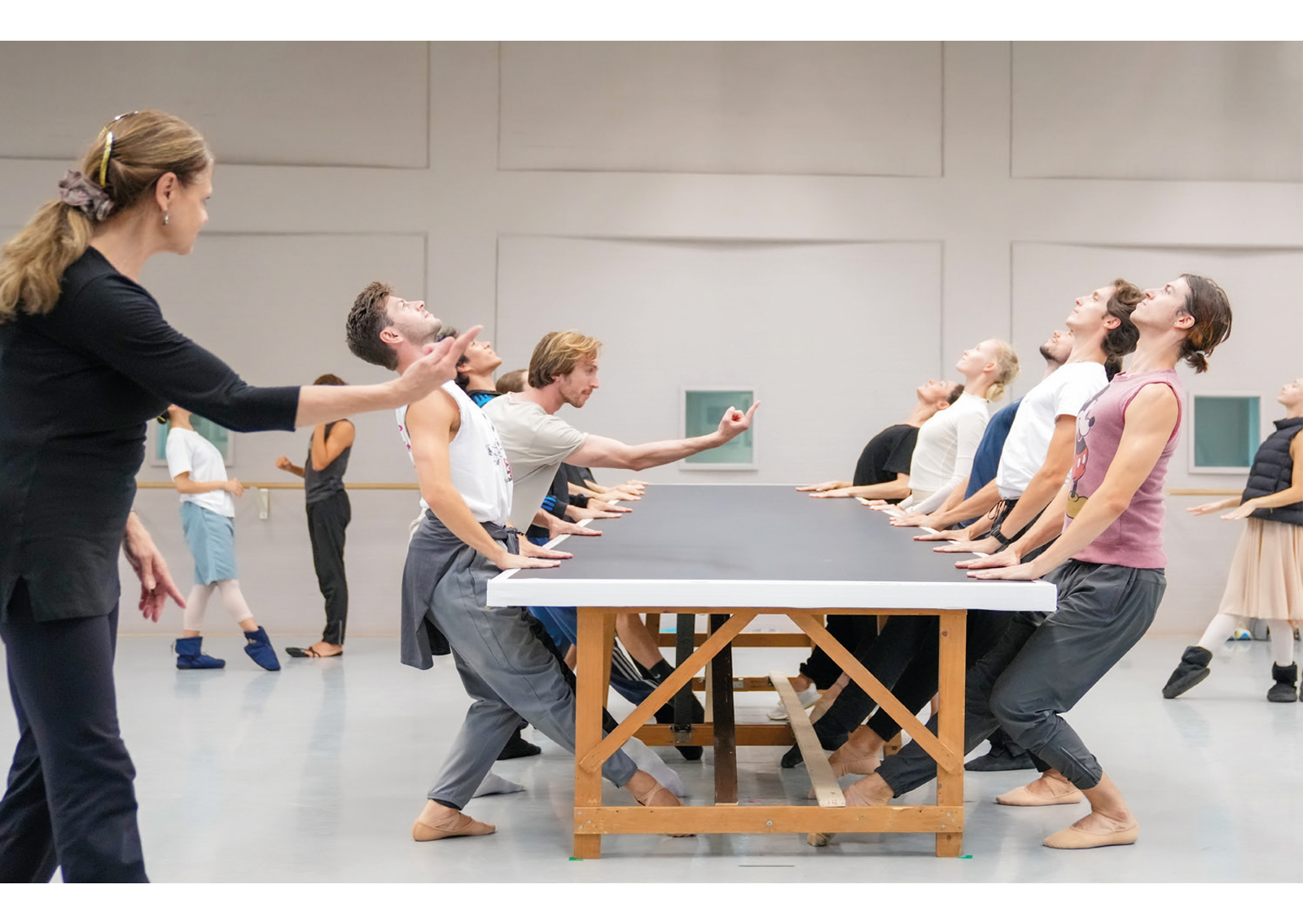
SEEING, RATHER THAN LOOKING
Ninety years after its premiere in Germany, when Nazism was on the rise, The Green Table is still affecting people, says Vondersaar. “Its universal and timeless message escapes no one.” She admits that from a technical point of view the ballet is probably dated. “Today’s audiences are used to seeing lots of pirouettes, big jumps and high extensions”, she says. “But it’s precisely the subdued nature of the work that makes it so impressive. In this case, less is more – and that demands ultimate control from the dancers.”
She knows from experience that this control is difficult for the present generation of dancers. “The Green Table is all about inner expression. You’re conveying an important message, so every movement and every gesture is essential. If you reach your arm out to somebody, for example, that movement has to be charged with energy. You have to really express something with your arms, and convey something to people very sincerely and purely. That sort of detail demands tremendous focus from the dancers. You need to be aware not only of yourself and your dance partner, but of everything and everyone around you. You have to see, rather than look.”
So at the start of the rehearsal process, she tells the dancers, “You’re going to have to be patient with me – and I with you.” This is because, “There’s a meaning behind each step, and I analyse the best way to convey that meaning for each dancer individually.”
‘THIS HAS TO GO ON’
On 3 July 2022, it was exactly ninety years since the premiere of The Green Table at the Théâtre des Champs-Élysées, in Paris. “I hope I’m still around for the centenary”, says Vondersaar, who is now 71. In recent years, she has been staging the ballet in collaboration with the Italian ballet master Claudio Schellino, whose enormous dedication she ‘discovered’ when she rehearsed The Green Table with Saarländisches Staatstheater, in Saarbrücken. “This collaboration is important, not only because my age now prevents me demonstrating all the movements, but also because the available rehearsal time is being cut back all over the world. When I started out with Anna Markard, we could count on a total of a hundred hours over at least a six-week period for staging The Green Table. Nowadays, you’re happy if you get four weeks to set the work.”
But with Schellino already at the age of 60, Vondersaar is once again looking for a new successor. “We’ve got our eye on a young person in their forties, who is working in Portugal at the moment. Because come what may, this has to go on. We absolutely have to keep this dance masterpiece alive.”
Author: Astrid van Leeuwen
programmaboek
Become a Friend of Dutch National Ballet
As a Friend you support the dancers and makers of Dutch National Ballet. You are indispensable to them and we are happy to do something in return. For Ballet Friends we organize exclusive activities behind the scenes. You will receive the Friends magazine from us, will receive priority when selling tickets and a 10% discount in the National Opera & Ballet shop.
